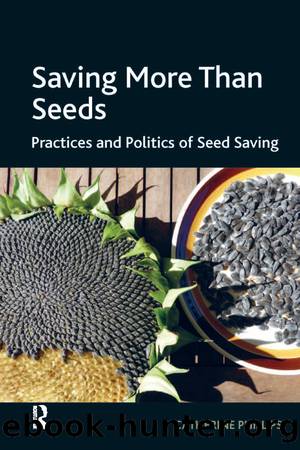Saving More Than Seeds by Catherine Phillips

Author:Catherine Phillips [Phillips, Catherine]
Language: eng
Format: epub
Tags: Social Science, Human Geography
ISBN: 9781317059400
Google: 9cDeCwAAQBAJ
Publisher: Routledge
Published: 2016-04-01T06:01:57+00:00
Knowing Carrots
Letâs start with carrots. âA day is coming when a single carrot, freshly observed, will set off a revolutionâ, said Paul Cézanne. He would not have been speaking of saving, growing or eating, but of art â specifically of the post-impressionist approach shifting art worlds. But we can still take a lesson: paying serious attention to seemingly insignificant things, sensing them anew, alters worlds â maybe even in revolutionary ways. As Law and Urry (2004: 391) suggest, âto change our understanding is to change the world, in small and sometimes major ways.â Painting for Cézanne was lived experience rather than objective representation, and he aimed to convey a sense of that living through his painting. But letâs get back to carrots â and the learning of them.
Learning and knowing carrots might be related first to eating practices. Carrots and consumersâ knowing of them provide material for Roeâs (2006a) investigation of edibility. Roeâs study, though primarily concerned with how GE foods become inedible, includes analysis of group discussions about edibility of three kinds of carrots: tinned; young and bunched; and, fat, mature. Taste is individual, she finds, but carrot materiality is important overall in determining edibility. How carrots look and feel â their appearance and textures â are clearly sensual and easily related with consumersâ material experiences, but âinvisibleâ properties â like vitamin levels or quality of sunshine â are also inferred. For her participants, how orange or how old a carrot appears, for instance, implies the carrotâs production processes and nutrition. Roe further argues that consumer considerations are both haptic and cognitive, integrating senses with memories, practices with preferences, and so on. Consumers judge whether they will eat carrots, and how, by material, affective and cognitive engagements (see also Eden et al.âs (2008) âmucky carrotsâ).
Carrots are not only those things weâre used to eating though, they have other experiences and other ways of knowing them. As Roe (2006a: 474) notes, â[c]arrot bodies, even when diced, sliced, boiled, fried, have a âsamenessâ that stands out more than that process by which it developed from seed to carrot shape.â If we want to know some of this carrot difference, we need to look at other carrotâpeople practices such as growing.
Second, then, learning carrots may manifest in growing practices. Pollan (1991: 118â20) recounts his own quest to grow carrots well â something he struggled to do season after season. In trying to understand what is going wrong with his carrots, asks himself, âwhat does a carrot care about?â and considers âwhat matters to them, what they require in order to fulfil the terms of their destiny.â After much careful thought and through experimenting with varied growing practices and spaces, the problem is found in heavy soil and crowded carrots. Pollan then goes about providing his carrots âa propitious place by lightening the soilâ, âruthlesslyâ thinning the seedlings, and finally growing carrots of which he is proud. Through his experience of learning carrots, Pollan develops skills that will now allow him to âgrow fine carrots without a momentâs reflection.
Download
This site does not store any files on its server. We only index and link to content provided by other sites. Please contact the content providers to delete copyright contents if any and email us, we'll remove relevant links or contents immediately.
Whiskies Galore by Ian Buxton(41529)
Introduction to Aircraft Design (Cambridge Aerospace Series) by John P. Fielding(32888)
Small Unmanned Fixed-wing Aircraft Design by Andrew J. Keane Andras Sobester James P. Scanlan & András Sóbester & James P. Scanlan(32573)
Aircraft Design of WWII: A Sketchbook by Lockheed Aircraft Corporation(32134)
Craft Beer for the Homebrewer by Michael Agnew(17933)
Turbulence by E. J. Noyes(7700)
The Complete Stick Figure Physics Tutorials by Allen Sarah(7137)
The Institute by Stephen King(6802)
Kaplan MCAT General Chemistry Review by Kaplan(6595)
The Thirst by Nesbo Jo(6435)
Bad Blood by John Carreyrou(6274)
Modelling of Convective Heat and Mass Transfer in Rotating Flows by Igor V. Shevchuk(6222)
Learning SQL by Alan Beaulieu(6035)
Weapons of Math Destruction by Cathy O'Neil(5829)
Man-made Catastrophes and Risk Information Concealment by Dmitry Chernov & Didier Sornette(5646)
Permanent Record by Edward Snowden(5537)
Digital Minimalism by Cal Newport;(5389)
Life 3.0: Being Human in the Age of Artificial Intelligence by Tegmark Max(5184)
iGen by Jean M. Twenge(5161)
